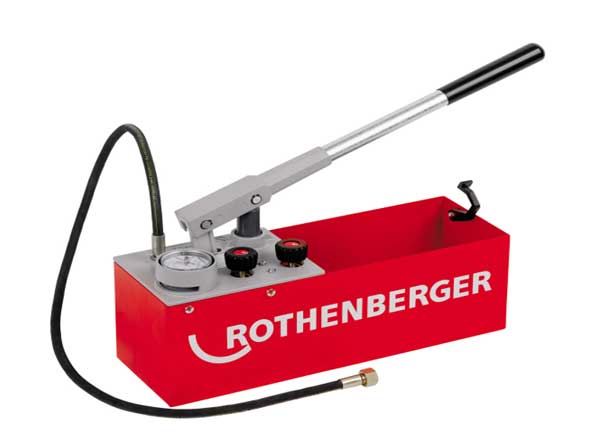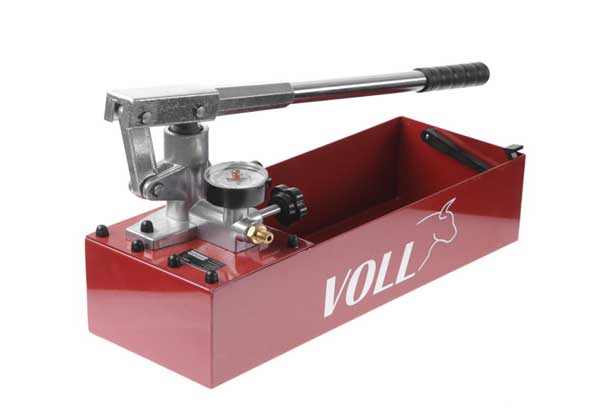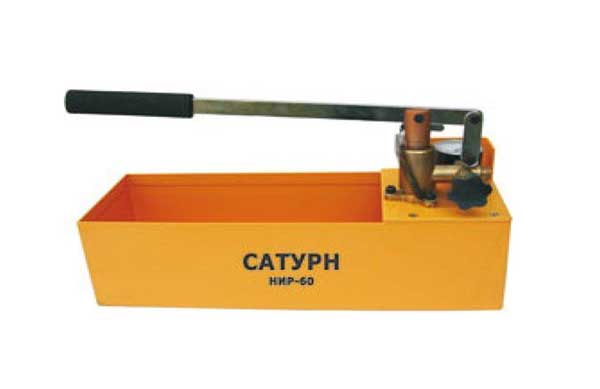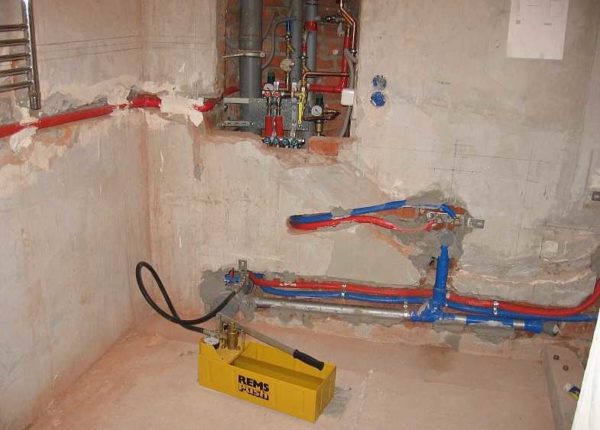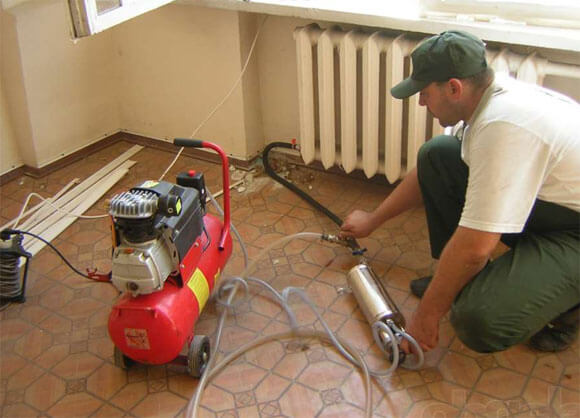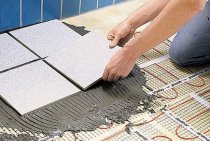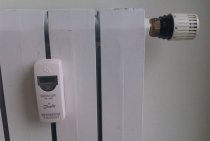Popular Models of Manual Crimping Pumps
On the Russian market, models of manual crimping machines of domestic and foreign manufacturers are widely represented, all of them are distinguished by their simple design and relatively low cost.
A wide range of pressure testing pumps is produced by the famous German company Rothenberger, which has more than 1200 employees and 12 factories in the USA and leading European countries.
Rothenberger RP 50 ($100) is a manual hydraulic pressure tester designed to check the tightness of pipes, assemblies and mechanisms in plumbing, plumbing and heating mains. The water tank is made of galvanized sheet steel, the device has a manometer in a metal case with three measurement scales and a built-in filter to protect against contamination. The pressure hose of the device is made in a durable fabric braid, the design provides for the presence of double valves, the device is designed to work with water and oil.
Technical parameters Rothenberger RP 50
- tank volume: 12 l.;
- maximum pressure: 50 bar.;
- liquid supply: 45 ml. per beat;
- outlet diameter: 1/2 inch;
- weight: 8 kg.
Rice. 6 German compressor for pressure testing of pipelines Rothenberger RP 50
Voll V-Test 50 (115 c.u.) - a pressure tester from a Belarusian manufacturer, has a durable steel tank, painted with powder-coated paint and a two-valve pump assembly made of corrosion-resistant brass. The manometer with three scales is responsible for the accuracy of measurements, the connected hose is made of rubber on a fabric basis, the unit works with water and oil.
- tank volume: 10 l.;
- maximum pressure: 50 bar.;
- serving: 45 ml. per beat;
- outlet diameter: 1/2 inch;
- weight: 8 kg.
Rice. 7 Mechanical pressure pump Voll V-Test 50
Saturn NIR-60 (110 c.u.) - manual test pump (NIR) from a domestic manufacturer, the device is designed for hydraulic testing of various containers and pipelines, the working fluid is oil and water.
Technical parameters Saturn NIR-60
- operating temperature of the liquid: 5 - 80 C.;
- tank volume: 12 l.;
- maximum pressure: 60 bar.;
- serving: 40 ml. per beat;
- outlet diameter: 1/2 inch.
Rice. 8 Manual pump for pressure testing of heating systems Saturn NIR-60
What is pressure testing of a heating and water supply system
Heating and water supply are two systems consisting of a large number of the most diverse equipment. As you know, the performance of any multicomponent system is determined by the weakest element - when it fails, it stops completely or partially. To identify all weaknesses, pressure testing of heating and water supply is carried out. In simple terms, the pressure is specially raised much higher than the working one, pumping liquid. They do this with the help of special equipment, control the pressure with a pressure gauge. The second name for pressure testing is hydraulic testing. It's probably understandable why.
Pressure testing of heating is carried out after any repair or before the heating season
When pressure testing of the heating system is carried out, the pressure is raised by 25-80%, depending on the type of pipes, radiators, and other equipment. It is clear that such a test reveals all weak points - everything that does not have a margin of safety breaks, leaks appear in worn pipes and unreliable connections. Having eliminated all the identified problems, we ensure the operability of our heating or water supply for a while.
If we are talking about centralized heating, then pressure testing is usually carried out immediately after the end of the season. In this case, there is a decent period of time for repairs.But this is not the only case when such events are held. Crimping still takes place after repair, replacement of any element. In principle, this is understandable - you need to check how reliable the new equipment and connections are. For example, you soldered heating from polypropylene pipes. It is necessary to check how good the connections turned out. This can be done by pressing.
If we talk about autonomous systems in private houses or apartments, then a new or repaired water supply is usually checked simply by starting the water, although even here a strength test will not hurt. But it is desirable to test the heating "to the full", both before commissioning and after repair. Keep in mind that those pipelines that are hidden in walls, in the floor or under a suspended ceiling must be tested before they are closed. Otherwise, if during testing it turns out that there are leaks, you will have to disassemble / break everything and fix the problems. Few people will be happy about it.
How to make the right choice
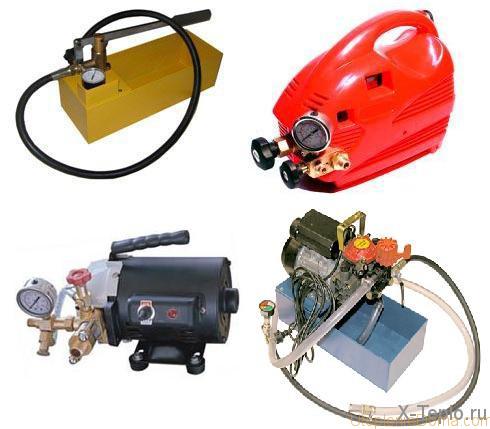
When choosing a pump, consider the total capacity of the system being treated and the frequency of pressure testing. On the market there are models of various brands, which you need to choose depending on their type. Manual models have a simplified design, do not cause difficulties and are inexpensive. But to create the desired level of pressure when working with them, you need to spend more time, unlike pumps with an electric drive. Devices differ in terms of the duration of work and are capable of producing results with different accuracy, which is affected by the power of a particular model.
If a pump with a low power is used during the procedure, it will take more time to test, since such devices slowly fill with water. It is necessary to choose a pressure tester taking into account the dimensions of the pipeline system that is being tested. If we are talking about a private house, you can purchase a special supercharger that passes 2-3 liters of fluid per minute. For multi-storey buildings and heating mains, circulation pumps are used to ensure continuous movement of fluid inside the system.
Crimping technology in an apartment building
The crimping procedure is performed according to a single algorithm, the implementation has some features in different cases.
Special services are required to carry out hydraulic tests before and after the heating season.
Also, this event is carried out after the repair or commissioning of the equipment.
The result of the event is documented and an appropriate act is drawn up.
Before pressing, carry out:
- inspection of the supply unit, pipeline and other parts of the system.
- checking the condition of the thermal insulation of the main line.
When operating for more than 5 years, it is recommended to flush the system before a hydraulic test. For this purpose, a special solution is poured into the pipes freed from the coolant.
Having completed these activities, proceed to crimping. The actions are in the following order.
- Water is poured into the newly installed or flushed system.
- With the help of special injection equipment, an increased pressure is created, which is controlled by a pressure gauge.
- If the pressure level remains unchanged for 15-30 minutes, then this indicates the tightness of the system and the reliability of the equipment that is included in it.
- If there is a decrease in pressure, then the reason for this is clarified.
- Having found out the place where the leak occurs, it is eliminated or the faulty element is changed and the procedure is repeated.
- The test is considered successful in case of a pressure drop of not more than 0.1 atm for 30 minutes.
Who does the pressing
The responsibility for monitoring the performance of the heating system and taking preventive measures lies with the organization that operates it. Municipal services deal with these issues in residential buildings, and in other enterprises and institutions - the corresponding technical services.
A certified specialist with the necessary qualifications is allowed to carry out work on pressure testing.

These works in private houses with autonomous heating are carried out by employees of service organizations or independently, as well as installation.
Regardless of who will carry out the pressure testing measures, one should adhere to the requirements and rules of the regulatory documents governing this type of work.
Carrying out preparatory work before pressing
Each heating system maintains a working pressure that provides movement along the coolant circuit necessary for heating pipes and heating radiators, which, in turn, heat the air around them in the room. The force of the working pressure must be sufficient to raise the coolant to the required height (for more details: “Working pressure in the heating system - standards and tests“). This leads to the conclusion that for taller houses a higher value of system pressure is required.
Before pressure testing of the heating system, it should be noted that when pressure testing with air, or pneumatic pressure testing, the working pressure should exceed the norm by 40-50%. The increase in pressure in the system is associated with ongoing hydraulic processes on the way of the coolant to the building from the main.
The procedure for pressure testing the heating system begins with preparatory work, including the following steps:
- Checking shut-off valves (for example, valves) in each section of the system
- Leak test, which can be ensured by sealing the required areas with glands
- Inspection and, if necessary, repair of elements intended for pipeline insulation
- Shutdown of the building in which the pressure test of the circuit is carried out, using a plug from the common heating system
Next, the drain valve, located on the "return", is prepared for further filling the pipes with tap water. When filling the heating system with water, it is necessary to close the valves, taps, and leave the air vents open.
How to crimp a collector heating system, a detailed video:
Installation and use of the pump
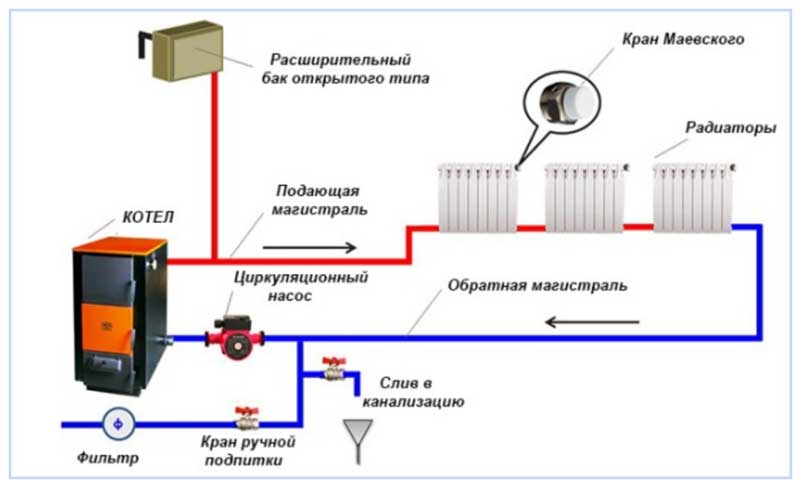
Crimping machines and hydraulic presses of various calibers are used to test heating and water supply systems, as well as plumbing installations. With their help, the integrity of individual sections is checked and various malfunctions are detected. First of all, testing with the help of a pressure tester is carried out during the commissioning of the system. During the installation of elements made of polypropylene, polyethylene or metal-plastic, gaps may form at the attachment points. In the future, any of these places can cause leakage during operation.
With the help of a pump, areas with a high risk of leakage can be quickly located. Inside the system, pressure is created with a level much higher than the maximum working one. If the pipes are able to withstand it for several hours, this indicates that they will work for a long time in normal mode. The pump also helps to evaluate the quality of the repair work carried out. All elements of the pipeline, for example, risers, must be checked before starting, forcing them to work under conditions of high pressure. Before work, it is necessary to prepare the system, if it is autonomous, you will need to turn off the heat generator.
In a non-autonomous system, the area to be checked is covered with cranes.
It is important to make sure that the coolant is drained.After the system circuit is filled with water heated to a temperature of no more than 45 degrees, in the process of filling the air will gradually leave
At the next stage, a compressor is connected for pressure testing, the pressure is brought to the working mark and the area is inspected for damage. Then the pressure is gradually increased and left at the desired level for 10-15 minutes. The pressure level is adjusted using a manometer. All places are inspected for leaks, check radiators, fittings and pipe walls, serviceability of all taps and valves.
Preventive pressure testing of systems allows you to prevent possible leaks and accidents, to identify and eliminate damage at an early stage. A hydraulic manual or electric press for pressure testing of pipelines additionally helps to determine the degree of wear of pipes and the estimated timing of their replacement.
Required tool
To create the required conditions during pressure testing, you need equipment that allows you to achieve the required pressure level. The most commonly used pump. It, together with a check valve, is connected to the system through a pipe using a high-pressure hose. The main characteristics when choosing a device are the level of performance and the pressure that it can create.
If the device is powered by electricity, then pay attention to the operating voltage (220 V or 380 V)
When carrying out work with a small volume of the circuit, it is advisable to use the manual design of the pressurizer, which is equipped with a hydraulic cylinder. It is possible to achieve greater efficiency and ease of use when using a piston device with an electric drive. The electric type of pressurizer will create the required pressure in a short time without the application of muscular effort. These devices, in addition to the pressure gauge, have equipment for monitoring and control.
In private houses, where the pressure in the system is low, it is filled with water, followed by fixing the pressure readings on the pressure gauge.
